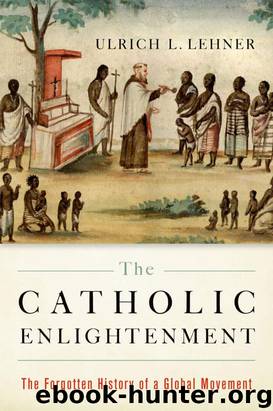The Catholic Enlightenment: The Forgotten History of a Global Movement by Ulrich L. Lehner

Author:Ulrich L. Lehner [Lehner, Ulrich L.]
Language: eng
Format: epub
Publisher: Oxford University Press
Published: 2016-01-06T08:00:00+00:00
Muratori and the Spirit of Liturgical Renewal
Nobody exemplifies the spirit of Catholic Enlightenment better than Ludovico Muratori, a librarian and priest in Modena who regularly engaged in literary disputes. Among his closest friends was Prospero Lambertini, who in 1740 became Pope Benedict XIV. Muratori was a man in dialogue with contemporary culture, who read everything he could get his hands on—science, history, philosophy, fiction. That so many of his countrymen were ignorant about the true content of their faith, could not see the joy of being Catholic and develop a personal relationship with Jesus, troubled him deeply. What made him angry, however, was when these people wasted their time with superstitious diversions instead of fulfilling the essential duties of a Christian life. Yet he also realized how hard it was to battle such ignorance, especially if it was buttressed by intransigent clergymen. He thought that it was predominantly pride and blind zeal that caused priests to resist the reforms inspired by Trent. By clinging to superstitious practices, they gave ammunition to the critics of the church. When an Italian priest tried to show the truth of Catholicism with some miracle stories, Muratori angrily replied, “The truth of the church is not in any need of fables.”13 Superstition was for him as bad as “heresy,” he declared in his major work, On the Moderation of Our Cleverness in Religious Matters (1714): “The monster of superstition comes into being due to ignorance, and is fed by immoderate zeal. … Stupid superstition is often to blame for the worst evils, namely that one resists the abolition of deep-rooted abuses that seem to be devout and pious.”14 Why were these abuses so dangerous? The devil, according to Catholic teaching, was unable to create anything meaningful by himself, yet he was a master of imitation. By making demonic rituals appear Catholic, the devil could tear away the faithful from the church. Muratori saw such dangers in exorcisms against mice and vermin, but also in prayers for the expulsion of demons from bread, milk, wine, and even bathing water.15
Since the end of the Council of Trent in 1563, the church had substantially reformed its practice of worship. Muratori joined this reform effort a few years before his death with the publication of a little book called Regulated Devotion (1747), whose English edition of 1789 was curiously titled The Science of Rational Devotion. At the heart of this book lies the distinction between essential and superficial forms of piety. Muratori argues that the main problem for Catholicism is that many faithful cling to superficial practices of piety and neglect the essential ones. It is, however, these superficial practices that most easily lead to superstition and thus away from the faith. By helping Catholics focus on what is central to their faith and by making it intelligible, he attempted to make Catholicism acceptable to more educated individuals. For Muratori, every essential mode of devotion was grounded either in Scripture or in a direct teaching of the church. He
Download
This site does not store any files on its server. We only index and link to content provided by other sites. Please contact the content providers to delete copyright contents if any and email us, we'll remove relevant links or contents immediately.
| Buddhism | Christianity |
| Ethnic & Tribal | General |
| Hinduism | Islam |
| Judaism | New Age, Mythology & Occult |
| Religion, Politics & State |
Cecilia; Or, Memoirs of an Heiress — Volume 1 by Fanny Burney(31356)
Cecilia; Or, Memoirs of an Heiress — Volume 3 by Fanny Burney(30954)
Cecilia; Or, Memoirs of an Heiress — Volume 2 by Fanny Burney(30909)
The Secret History by Donna Tartt(16680)
Sapiens: A Brief History of Humankind by Yuval Noah Harari(13088)
Leonardo da Vinci by Walter Isaacson(11927)
The Radium Girls by Kate Moore(10929)
Sapiens by Yuval Noah Harari(4560)
The Wind in My Hair by Masih Alinejad(4431)
How Democracies Die by Steven Levitsky & Daniel Ziblatt(4430)
Homo Deus: A Brief History of Tomorrow by Yuval Noah Harari(4294)
Endurance: Shackleton's Incredible Voyage by Alfred Lansing(3857)
The Silk Roads by Peter Frankopan(3795)
Man's Search for Meaning by Viktor Frankl(3657)
Millionaire: The Philanderer, Gambler, and Duelist Who Invented Modern Finance by Janet Gleeson(3577)
The Rape of Nanking by Iris Chang(3531)
Hitler in Los Angeles by Steven J. Ross(3450)
The Motorcycle Diaries by Ernesto Che Guevara(3348)
Joan of Arc by Mary Gordon(3272)
